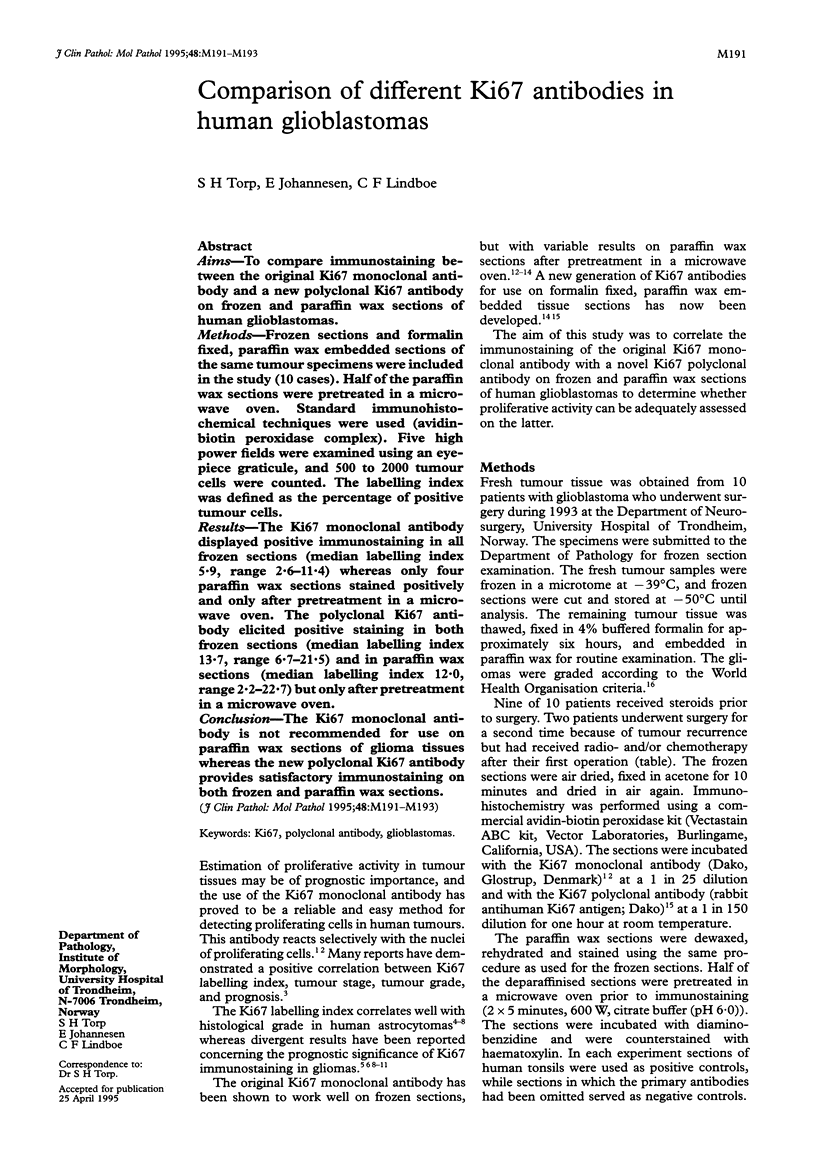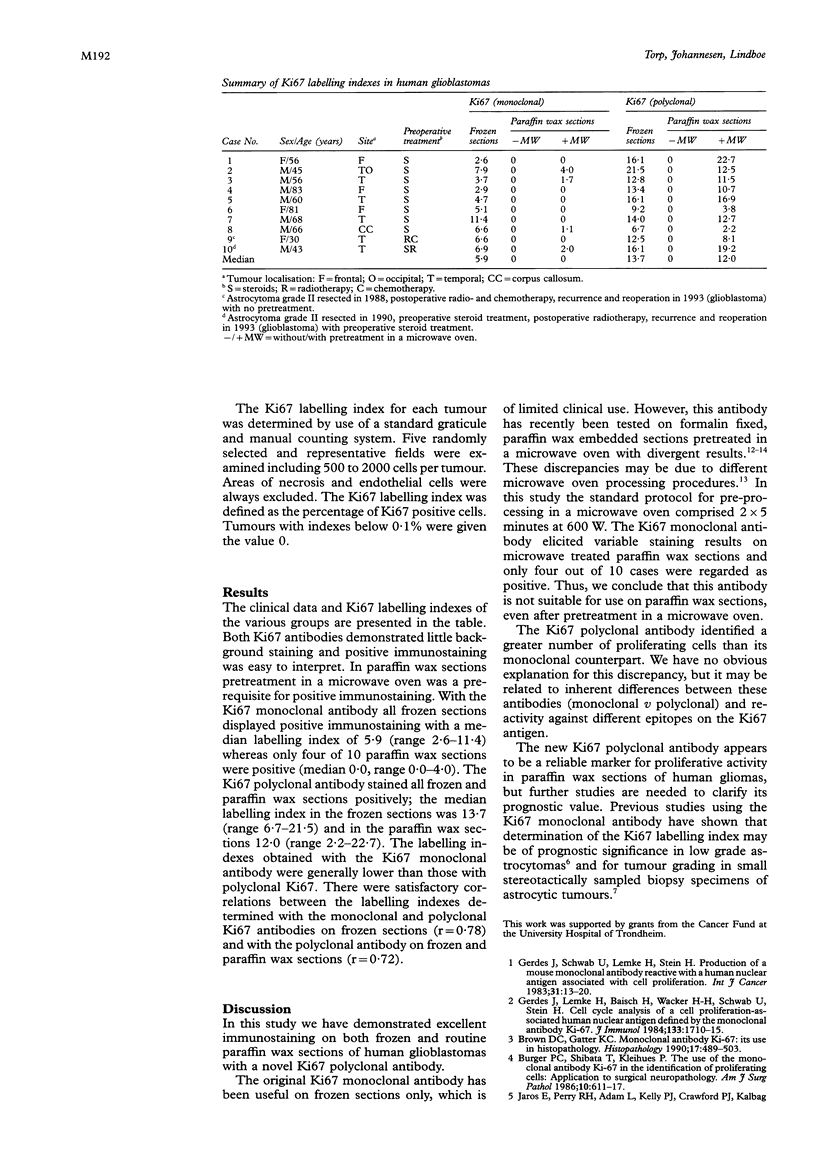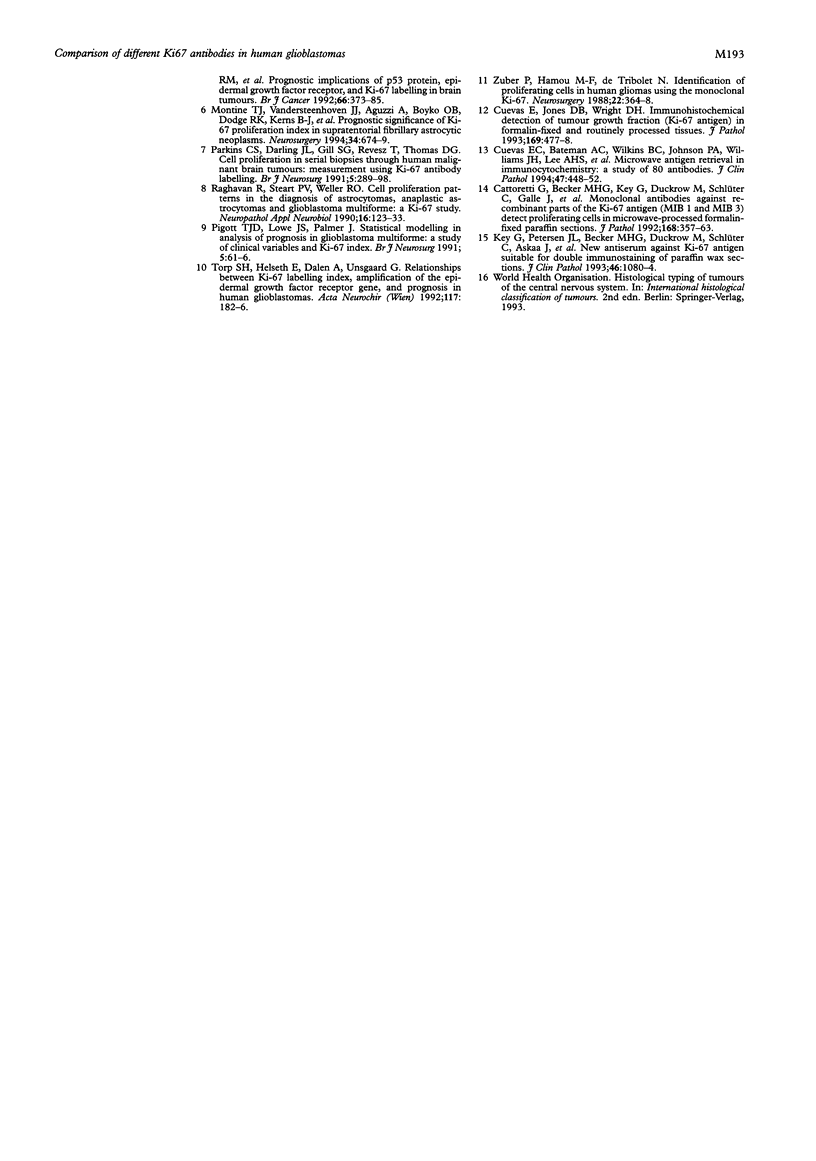Abstract
Aims—To compare immunostaining between the original Ki67 monoclonal antibody and a new polyclonal Ki67 antibody on frozen and paraffin wax sections of human glioblastomas.
Methods—Frozen sections and formalin fixed, paraffin wax embedded sections of the same tumour specimens were included in the study (10 cases). Half of the paraffin wax sections were pretreated in a microwave oven. Standard immunohistochemical techniques were used (avidinbiotin peroxidase complex). Five high power fields were examined using an eye-piece graticule, and 500 to 2000 tumour cells were counted. The labelling index was defined as the percentage of positive tumour cells.
Results—The Ki67 monoclonal antibody displayed positive immunostaining in all frozen sections (median labelling index 5·9, range 2·6-11·4) whereas only four paraffin wax sections stained positively and only after pretreatment in a microwave oven. The polyclonal Ki67 antibody elicited positive staining in both frozen sections (median labelling index 13·7, range 6·7-21·5) and in paraffin wax sections (median labelling index 12·0, range 2·2-22·7) but only after pretreatment in a microwave oven.
Conclusion—The Ki67 monoclonal antibody is not recommended for use on paraffin wax sections of glioma tissues whereas the new polyclonal Ki67 antibody provides satisfactory immunostaining on both frozen and paraffin wax sections.
Keywords: Ki67, polyclonal antibody, glioblastomas
Full text
PDF


Selected References
These references are in PubMed. This may not be the complete list of references from this article.
- Brown D. C., Gatter K. C. Monoclonal antibody Ki-67: its use in histopathology. Histopathology. 1990 Dec;17(6):489–503. doi: 10.1111/j.1365-2559.1990.tb00788.x. [DOI] [PubMed] [Google Scholar]
- Burger P. C., Shibata T., Kleihues P. The use of the monoclonal antibody Ki-67 in the identification of proliferating cells: application to surgical neuropathology. Am J Surg Pathol. 1986 Sep;10(9):611–617. doi: 10.1097/00000478-198609000-00003. [DOI] [PubMed] [Google Scholar]
- Cattoretti G., Becker M. H., Key G., Duchrow M., Schlüter C., Galle J., Gerdes J. Monoclonal antibodies against recombinant parts of the Ki-67 antigen (MIB 1 and MIB 3) detect proliferating cells in microwave-processed formalin-fixed paraffin sections. J Pathol. 1992 Dec;168(4):357–363. doi: 10.1002/path.1711680404. [DOI] [PubMed] [Google Scholar]
- Cuevas E. C., Bateman A. C., Wilkins B. S., Johnson P. A., Williams J. H., Lee A. H., Jones D. B., Wright D. H. Microwave antigen retrieval in immunocytochemistry: a study of 80 antibodies. J Clin Pathol. 1994 May;47(5):448–452. doi: 10.1136/jcp.47.5.448. [DOI] [PMC free article] [PubMed] [Google Scholar]
- Cuevas E., Jones D. B., Wright D. H. Immunohistochemical detection of tumour growth fraction (Ki-67 antigen) in formalin-fixed and routinely processed tissues. J Pathol. 1993 Apr;169(4):477–478. doi: 10.1002/path.1711690415. [DOI] [PubMed] [Google Scholar]
- Gerdes J., Lemke H., Baisch H., Wacker H. H., Schwab U., Stein H. Cell cycle analysis of a cell proliferation-associated human nuclear antigen defined by the monoclonal antibody Ki-67. J Immunol. 1984 Oct;133(4):1710–1715. [PubMed] [Google Scholar]
- Gerdes J., Schwab U., Lemke H., Stein H. Production of a mouse monoclonal antibody reactive with a human nuclear antigen associated with cell proliferation. Int J Cancer. 1983 Jan 15;31(1):13–20. doi: 10.1002/ijc.2910310104. [DOI] [PubMed] [Google Scholar]
- Key G., Petersen J. L., Becker M. H., Duchrow M., Schlüter C., Askaa J., Gerdes J. New antiserum against Ki-67 antigen suitable for double immunostaining of paraffin wax sections. J Clin Pathol. 1993 Dec;46(12):1080–1084. doi: 10.1136/jcp.46.12.1080. [DOI] [PMC free article] [PubMed] [Google Scholar]
- Montine T. J., Vandersteenhoven J. J., Aguzzi A., Boyko O. B., Dodge R. K., Kerns B. J., Burger P. C. Prognostic significance of Ki-67 proliferation index in supratentorial fibrillary astrocytic neoplasms. Neurosurgery. 1994 Apr;34(4):674–679. doi: 10.1227/00006123-199404000-00016. [DOI] [PubMed] [Google Scholar]
- Pigott T. J., Lowe J. S., Palmer J. Statistical modelling in analysis of prognosis in glioblastoma multiforme: a study of clinical variables and Ki-67 index. Br J Neurosurg. 1991;5(1):61–66. doi: 10.3109/02688699108998448. [DOI] [PubMed] [Google Scholar]
- Raghavan R., Steart P. V., Weller R. O. Cell proliferation patterns in the diagnosis of astrocytomas, anaplastic astrocytomas and glioblastoma multiforme: a Ki-67 study. Neuropathol Appl Neurobiol. 1990 Apr;16(2):123–133. doi: 10.1111/j.1365-2990.1990.tb00941.x. [DOI] [PubMed] [Google Scholar]
- Torp S. H., Helseth E., Dalen A., Unsgaard G. Relationships between Ki-67 labelling index, amplification of the epidermal growth factor receptor gene, and prognosis in human glioblastomas. Acta Neurochir (Wien) 1992;117(3-4):182–186. doi: 10.1007/BF01400618. [DOI] [PubMed] [Google Scholar]
- Zuber P., Hamou M. F., de Tribolet N. Identification of proliferating cells in human gliomas using the monoclonal antibody Ki-67. Neurosurgery. 1988 Feb;22(2):364–368. doi: 10.1227/00006123-198802000-00015. [DOI] [PubMed] [Google Scholar]


